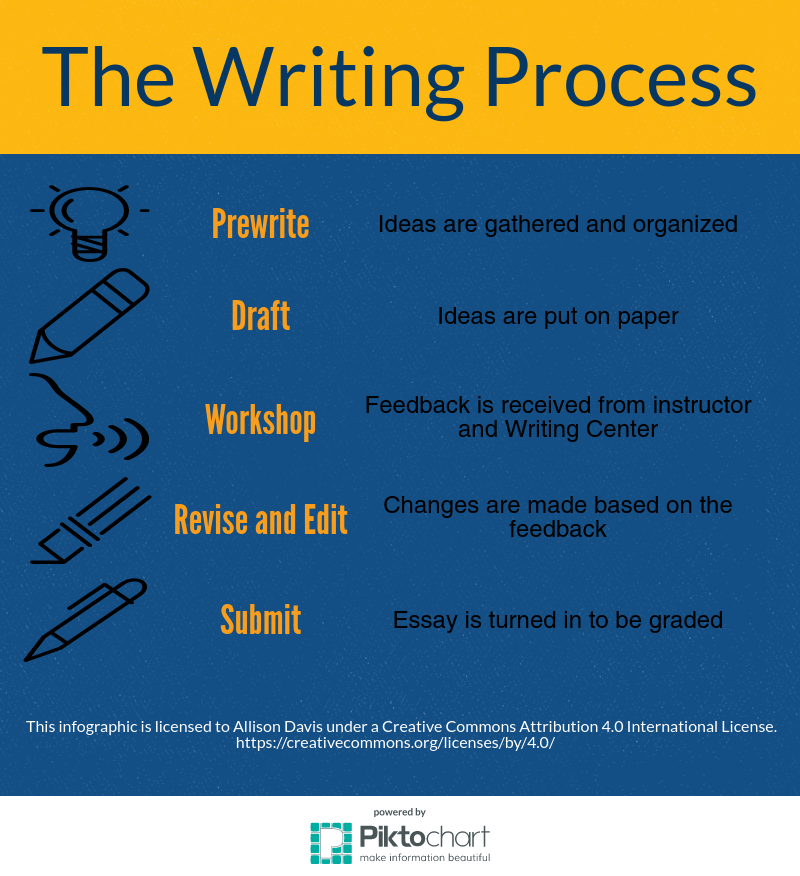Chapter 1-The Writing Process
You are likely familiar with the writing process by this point in your academic career. You might have looked at the chapter title and thought, “Oh no! Not again!” If that is the case, feel free to use your skimming skills as you look through this chapter, and remember some students have more experience in academic writing than others.
You might wonder, “Why do teachers insist on discussing the writing process every semester?” Well, it’s because writing is truly a PROCESS, and we don’t want you to forget that! It is ineffective to try to skip steps or take shortcuts.
The writing process consists of five steps:
- Prewriting
- Drafting
- Revising
- Editing
- Publication (final draft)
Prewriting
This step occurs when a student determines the topic, brainstorms ideas and details, and organizes the essay. This is an essential step in the writing process and is NOT to be skipped! If you skip this step, your essay will often appear unorganized or fail to include valuable information.
Student Activity 1: Visit this website to learn about five different types of prewriting. You will complete a jigsaw in small groups and share your findings with the class.
Drafting
Drafting is the next step in the writing process; the best thing you can do to generate content is just get started writing! Sometimes students are unsure of how to start or what to say, but if you just start writing anything related to your topic, the ideas typically begin flowing.
Don’t worry about mistakes when drafting, although you will want to include basic conventions so that the editing process is easier. However, don’t stress about grammar, punctuation, or spelling errors. You will correct those in due time. Use the information from your prewriting to guide you through the drafting process.
Revising
Many people don’t know the difference between the next two steps: Revising and editing.
Revising is NOT the same as editing. Revising involves changing the actual content of your draft. In this step, you add details, reorder sentences, remove sentences that are off-topic, and improve the quality of your writing.
Student Activity 2: Revise the content of the paragraph below. Consider adding to sentences, deleting sentences that don’t belong, or improving word use.
Adapting to a new country, and its culture, is an often difficult process and requires a lot of learning and new experiences. As a non-native leaving in a new country, learning to take in a different way of live and custom is something that foreigners experience globally. People come to immigrate for all different reasons and gols in mind. Living in America, it’s a constant learning process the culture and education. There are certain things that America does to help provide a smoother transition to living in the country like providing ESL classes that help students who aren’t fluent in English to help improve their understanding and use of the language. Make use of these resources available is helpful but it’s still a challenge to fully adapt to life in America. In my case, I came to the U.S. as a student from Japan, and since I had never been abroad for 18 years, it took me quite a while to get used to life in the U.S., and even now, I sometimes face various problems due to my unfamiliarity with this country, and I really miss my cat. Therefore, it’s common for non-natives to face many challenges such as language, earning money, and discrimination.
Editing
When editing, you will check for mistakes in grammar, punctuation, and spelling. Don’t be afraid to use a grammar checker! In fact, you should use one! Grammar checkers are great tools for helping you find your mistakes. Additionally, this is the step where you might visit with a tutor for help or ask a classmate to peer edit your writing.
Student Activity 3: Read the essay; edit the content in the essay.
Adapting to a new country, and its culture, is an often difficult process and requires a lot of learning and new experiences. As a non-native leaving in a new country, learning to take in a different way of live and custom is something that foreigners experience globally. People come to immigrate for all different reasons and gols in mind. Living in America, it’s a constant learning process the culture and education. There are certain things that America does to help provide a smoother transition to living in the country like providing ESL classes that help students who aren’t fluent in English to help improve their understanding and use of the language. Make use of these resources available is helpful but it’s still a challenge to fully adapt to life in America. In my case, I came to the U.S. as a student from Japan, and since I had never been abroad for 18 years, it took me quite a while to get used to life in the U.S., and even now, I sometimes face various problems due to my unfamiliarity with this country, and I really miss my cat. Therefore, it’s common for non-natives to face many challenges such as language, earning money, and discrimination.
Publication (final draft)
At this step, your writing is complete and perfect (or as perfect you can get it)! If you were a professional writer, your writing would be ready to be published in a magazine or on a website. But since you are student, your writing is ready for review by your teacher and possibly to share with fellow students or the community.
Chapter Questions:
- Name and describe the five steps of the writing process.
- What is the difference between revising and editing?
- What is a type of prewriting that you think you will use for essay writing? Tell why you chose that strategy.

